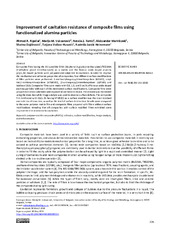Improvement of cavitation resistance of composite films using functionalized alumina particles
Аутори
Algellai, Ahmed A.Vuksanović, Marija M.

Tomić, Nataša

Marinković, Aleksandar

Dojčinović, Marina

Volkov-Husović, Tatjana

Jančić-Heinemann, Radmila

Чланак у часопису (Објављена верзија)
Метаподаци
Приказ свих података о документуАпстракт
Composite films having the UV cured Bis-GMA (Bisphenol A glycidylmethacrylate)/TEGDMA (triethylene glycol dimethacrylate) as a matrix and the ferrous oxide doped alumina (Al2O3 Fe) based particles were prepared and subjected to cavitation. In order to improve the mechanical and adhesion properties of composites, four different surface modifications of filler particles were performed: 3-methacryloxypropyltrimethoxysilane (MEMO), vinyltris(2-methoxyethoxy)silane (VTMOEO), (3-aminopropyl)trimethoxysilane (APTMS) and biodiesel (BD). Composite films were made with 0.5,1.5, and 3 wt.% of ferrous oxide doped alumina particles with each of the mentioned surface modifications. Composite films were prepared on brass substrates and exposed to cavitation erosion. The erosion was monitored using the mass loss while image analysis was used to observe surface defects. The composite film reinforced with Al2O3 Fe having VTMOEO as a surface modifier was the most resistant one in terms of mass loss, as w...ell as the level of surface destruction. Results were compared to the same polymer matrix film and composite films prepared with fillers without surface modifications revealing that all composites with surface modified fillers exhibited some improvement in resistance to cavitation.
Кључне речи:
polymer-matrix composites (PMCs) / adhesion / surface modification / image analysis / cavitation erosionИзвор:
Hemijska industrija, 2018, 72, 4, 205-213Издавач:
- Savez hemijskih inženjera, Beograd
Финансирање / пројекти:
- Развој опреме и процеса добијања полимерних композитних материјала са унапред дефинисаним функционалним својствима (RS-MESTD-Technological Development (TD or TR)-34011)
- Синтеза, процесирање и карактеризација наноструктурних материјала за примену у области енергије, механичког инжењерства, заштите животне стредине и биомедицине (RS-MESTD-Integrated and Interdisciplinary Research (IIR or III)-45012)
DOI: 10.2298/HEMIND180308011A
ISSN: 0367-598X
WoS: 000440182100004
Scopus: 2-s2.0-85054030589
Колекције
Институција/група
Tehnološko-metalurški fakultetTY - JOUR AU - Algellai, Ahmed A. AU - Vuksanović, Marija M. AU - Tomić, Nataša AU - Marinković, Aleksandar AU - Dojčinović, Marina AU - Volkov-Husović, Tatjana AU - Jančić-Heinemann, Radmila PY - 2018 UR - http://TechnoRep.tmf.bg.ac.rs/handle/123456789/3883 AB - Composite films having the UV cured Bis-GMA (Bisphenol A glycidylmethacrylate)/TEGDMA (triethylene glycol dimethacrylate) as a matrix and the ferrous oxide doped alumina (Al2O3 Fe) based particles were prepared and subjected to cavitation. In order to improve the mechanical and adhesion properties of composites, four different surface modifications of filler particles were performed: 3-methacryloxypropyltrimethoxysilane (MEMO), vinyltris(2-methoxyethoxy)silane (VTMOEO), (3-aminopropyl)trimethoxysilane (APTMS) and biodiesel (BD). Composite films were made with 0.5,1.5, and 3 wt.% of ferrous oxide doped alumina particles with each of the mentioned surface modifications. Composite films were prepared on brass substrates and exposed to cavitation erosion. The erosion was monitored using the mass loss while image analysis was used to observe surface defects. The composite film reinforced with Al2O3 Fe having VTMOEO as a surface modifier was the most resistant one in terms of mass loss, as well as the level of surface destruction. Results were compared to the same polymer matrix film and composite films prepared with fillers without surface modifications revealing that all composites with surface modified fillers exhibited some improvement in resistance to cavitation. PB - Savez hemijskih inženjera, Beograd T2 - Hemijska industrija T1 - Improvement of cavitation resistance of composite films using functionalized alumina particles EP - 213 IS - 4 SP - 205 VL - 72 DO - 10.2298/HEMIND180308011A ER -
@article{
author = "Algellai, Ahmed A. and Vuksanović, Marija M. and Tomić, Nataša and Marinković, Aleksandar and Dojčinović, Marina and Volkov-Husović, Tatjana and Jančić-Heinemann, Radmila",
year = "2018",
abstract = "Composite films having the UV cured Bis-GMA (Bisphenol A glycidylmethacrylate)/TEGDMA (triethylene glycol dimethacrylate) as a matrix and the ferrous oxide doped alumina (Al2O3 Fe) based particles were prepared and subjected to cavitation. In order to improve the mechanical and adhesion properties of composites, four different surface modifications of filler particles were performed: 3-methacryloxypropyltrimethoxysilane (MEMO), vinyltris(2-methoxyethoxy)silane (VTMOEO), (3-aminopropyl)trimethoxysilane (APTMS) and biodiesel (BD). Composite films were made with 0.5,1.5, and 3 wt.% of ferrous oxide doped alumina particles with each of the mentioned surface modifications. Composite films were prepared on brass substrates and exposed to cavitation erosion. The erosion was monitored using the mass loss while image analysis was used to observe surface defects. The composite film reinforced with Al2O3 Fe having VTMOEO as a surface modifier was the most resistant one in terms of mass loss, as well as the level of surface destruction. Results were compared to the same polymer matrix film and composite films prepared with fillers without surface modifications revealing that all composites with surface modified fillers exhibited some improvement in resistance to cavitation.",
publisher = "Savez hemijskih inženjera, Beograd",
journal = "Hemijska industrija",
title = "Improvement of cavitation resistance of composite films using functionalized alumina particles",
pages = "213-205",
number = "4",
volume = "72",
doi = "10.2298/HEMIND180308011A"
}
Algellai, A. A., Vuksanović, M. M., Tomić, N., Marinković, A., Dojčinović, M., Volkov-Husović, T.,& Jančić-Heinemann, R.. (2018). Improvement of cavitation resistance of composite films using functionalized alumina particles. in Hemijska industrija Savez hemijskih inženjera, Beograd., 72(4), 205-213. https://doi.org/10.2298/HEMIND180308011A
Algellai AA, Vuksanović MM, Tomić N, Marinković A, Dojčinović M, Volkov-Husović T, Jančić-Heinemann R. Improvement of cavitation resistance of composite films using functionalized alumina particles. in Hemijska industrija. 2018;72(4):205-213. doi:10.2298/HEMIND180308011A .
Algellai, Ahmed A., Vuksanović, Marija M., Tomić, Nataša, Marinković, Aleksandar, Dojčinović, Marina, Volkov-Husović, Tatjana, Jančić-Heinemann, Radmila, "Improvement of cavitation resistance of composite films using functionalized alumina particles" in Hemijska industrija, 72, no. 4 (2018):205-213, https://doi.org/10.2298/HEMIND180308011A . .


